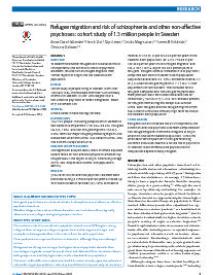Refugee migration and risk of schizophrenia and other non-affective psychoses: cohort study of 1.3 million people in Sweden
Objective To determine whether refugees are at elevated risk of schizophrenia and other non-affective psychotic disorders, relative to non-refugee migrants from similar regions of origin and the Swedish-born population. Design Cohort study of people living in Sweden, born after 1 January 1984 and followed from their 14th birthday or arrival in Sweden, if later, until diagnosis of a non-affective psychotic disorder, emigration, death, or 31 December 2011.Setting Linked Swedish national register data. Participants 1 347 790 people, including people born in Sweden to two Swedish-born parents (1 191 004; 88.4%), refugees (24 123; 1.8%), and non-refugee migrants (132 663; 9.8%) from four major refugee generating regions: the Middle East and north Africa, sub-Saharan Africa, Asia, and Eastern Europe and Russia. Main outcom e measures Cox regression analysis was used to estimate adjusted hazard ratios for non-affective psychotic disorders by refugee status and region of origin, controlling for age
at risk, sex, disposable income, and population density. Results 3704 cases of non-affective psychotic disorder were identified during 8.9 million person years of follow-up. The crude incidence rate was 38.5 (95% confidenceinterval 37.2 to 39.9) per 100 000 person years in the Swedish-born population, 80.4 (72.7 to 88.9) per 100 000 person years in non-refugee migrants, and 126.4 (103.1 to 154.8) per 100 000 person years in refugees. Refugees were at increased risk of psychosis compared with both the Swedish-born population (adjusted hazard ratio 2.9, 95% confidence interval 2.3 to 3.6) and non-refugee migrants (1.7, 1.3 to 2.1) after adjustment for confounders. The increased rate in refugees compared with non-refugee migrants was more pronounced in men (likelihood ratio test for interaction ÷2 (df=2) z=13.5; P=0.001) and was present for refugees from all regions except sub-Saharan Africa. Both refugees and non-refugee migrants from sub-Saharan Africa had similarly high rates relative to the Swedish-born population. Conclusions Refugees face an increased risk of schizophrenia and other non-affective psychotic disorders compared with non-refugee migrants from similar egions of origin and the native-born Swedish population. Clinicians and health service planners in refugee receiving countries should be aware of a raised risk of psychosis in addition to other mental and physical health inequalities experienced by refugees.
Geachte bezoeker,
De informatie die u nu opvraagt, kan door psychotraumanet niet aan u worden getoond. Dit kan verschillende redenen hebben,
waarvan (bescherming van het) auteursrecht de meeste voorkomende is. Wanneer het mogelijk is om u door te verwijzen naar de bron
van deze informatie, dan ziet u hier onder een link naar die plek.
Als er geen link staat, kunt u contact opnemen met de bibliotheek,
die u verder op weg kan helpen.
Met vriendelijke groet,
Het psychotraumanet-team.
Reference:
Anna-Clara Hollander, Henrik Dal, Glyn Lewis, Cecilia Magnusson, James B. Kirkbride, & Christina Dalman | 2016
In: BMJ : British medical journal, ISSN 0959-8138 | 352 | i1030
http://www.bmj.com/content/352/bmj.i1030
BMJ 2016;352:
In: BMJ : British medical journal, ISSN 0959-8138 | 352 | i1030
http://www.bmj.com/content/352/bmj.i1030
BMJ 2016;352:


